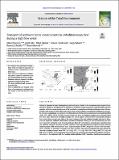Por favor, use este identificador para citar o enlazar a este item:
http://hdl.handle.net/10261/219196COMPARTIR / EXPORTAR:
 SHARE SHARE
 CORE
BASE CORE
BASE
|
|
| Visualizar otros formatos: MARC | Dublin Core | RDF | ORE | MODS | METS | DIDL | DATACITE | |

| Título: | Transport of sediment borne contaminants in a Mediterranean river during a high flow event |
Autor: | Herrero, A.; Vila, Judit CSIC; Eljarrat, Ethel CSIC ORCID ; Ginebreda Martí, Antoni CSIC ORCID; Sabater, Sergi; Batalla, R.J.; Barceló, Damià CSIC ORCID | Fecha de publicación: | 2018 | Citación: | Science of the Total Environment 633: 1392- 1402 (2018) | Resumen: | Pollutants’ dynamics in rivers flowing through industrial areas is linked to the entrainment and transport of contaminants attached to solid particles. The transport of sediment is mainly associated to high discharges and flood episodes, and these events constitute one of the main factors causing fluxes of buried pollutants in rivers. We performed a field study in the lower River Cinca (Ebro basin, Northeast Spain) to quantify the mobilization and transfer of several contaminants present in the river bed sediments. We focused on contaminants previously identified (PCBs, DDXs, PBDEs, HBCDs and PFRs) to occur in the river. River bed sediment samples were collected during low flows and a subsequent sampling campaign was used to capture sediment borne contaminants during a flood event. Water samples were taken at the same locations as the static sediment samples and used to determine the suspended sediment concentrations and the contaminants content (i.e. mass of contaminant per sediment mass unit) during the event. We estimated mass fluxes for both sediment and pollutants, and determined that sediment transport followed a clockwise hysteresis. This is typically observed in high flow events after dry summer periods. With sediments there was a large mobilization of PFRs (36 kg in 48 h in one of the main tributaries) and PCBs not previously observed in the static sediment. Observed contaminant load ranges during the two-day sampling campaign were: PCB (34–152 g), DDT (12–213 g), PBDE (50–1740 g), HBCD (0–2.2 g) and PFR (2410–35,895 g). An environmental risk assessment was carried out by comparing the pollutant concentrations found in the sediments with the Canadian quality guidelines (ISQC), showing a significant noncompliance for PCBs in dynamic sediments. Our results point out to the need of a regular assessment of the downstream transfer of the sediment-borne pollutants in drainage basins historically affected by intense industrial activities and associated contamination. | Versión del editor: | http://dx.doi.org/10.1016/j.scitotenv.2018.03.205 | URI: | http://hdl.handle.net/10261/219196 | DOI: | 10.1016/j.scitotenv.2018.03.205 | Identificadores: | doi: 10.1016/j.scitotenv.2018.03.205 issn: 1879-1026 |
| Aparece en las colecciones: | (IDAEA) Artículos |
Ficheros en este ítem:
| Fichero | Descripción | Tamaño | Formato | |
|---|---|---|---|---|
| 1-s2.0-S0048969718309641-main.pdf | 2,08 MB | Adobe PDF |  Visualizar/Abrir |
CORE Recommender
SCOPUSTM
Citations
28
checked on 29-abr-2024
WEB OF SCIENCETM
Citations
24
checked on 24-feb-2024
Page view(s)
129
checked on 30-abr-2024
Download(s)
109
checked on 30-abr-2024
Google ScholarTM
Check
Altmetric
Altmetric
NOTA: Los ítems de Digital.CSIC están protegidos por copyright, con todos los derechos reservados, a menos que se indique lo contrario.
